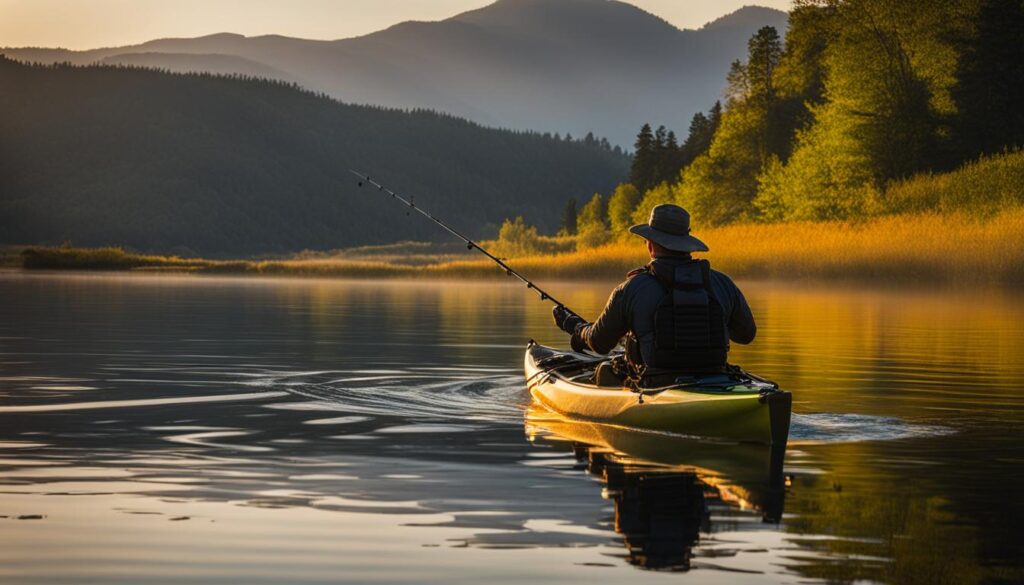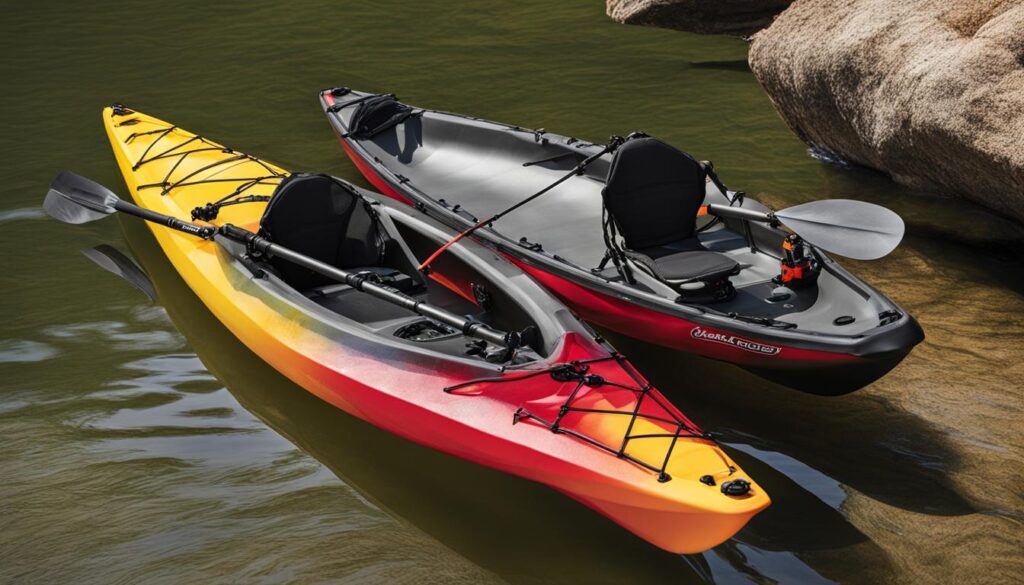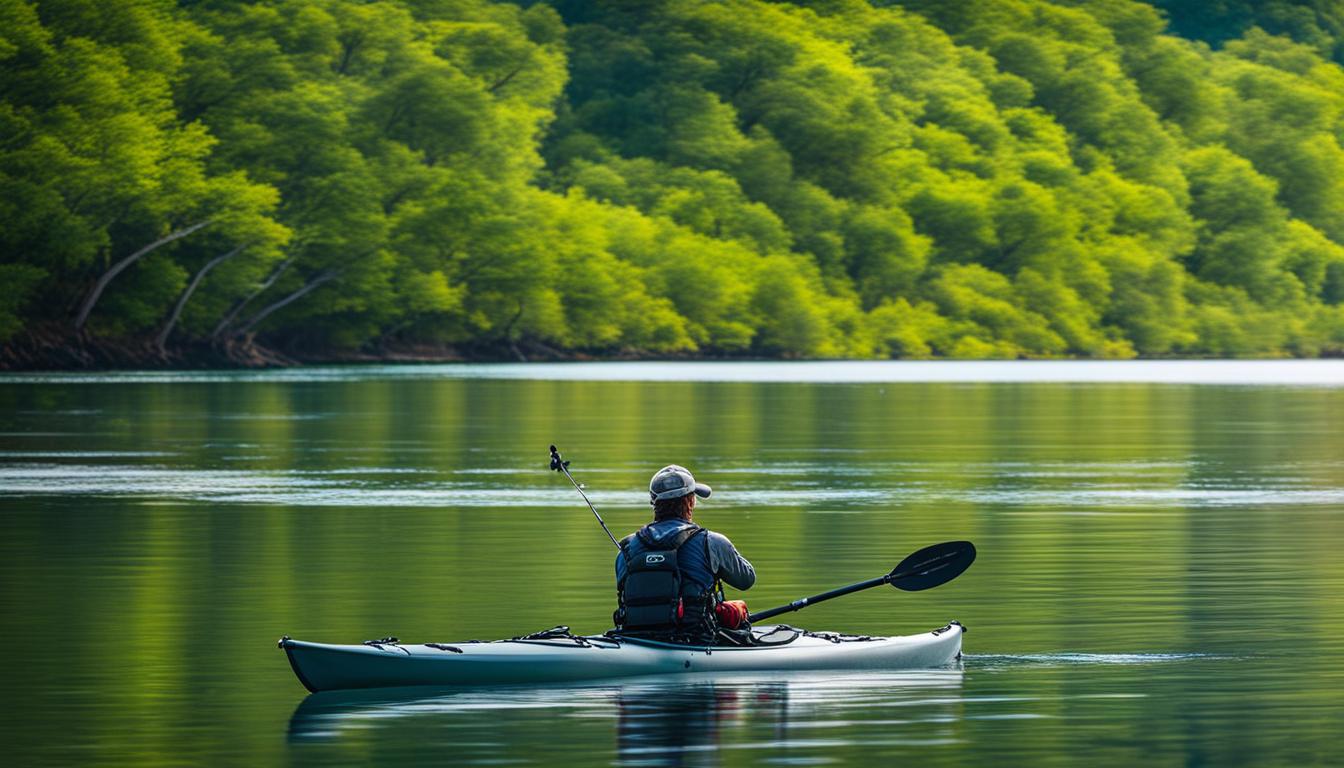Fishing from a kayak combines the excitement of fishing with the adventure of kayaking. It allows you to access remote areas where larger boats cannot go, giving you the opportunity to explore hidden fishing spots. Whether you’re a beginner or an experienced angler, kayaking offers a unique and immersive way to connect with nature and enjoy the sport of fishing.
To ensure a successful and safe kayak fishing trip, it’s important to familiarize yourself with kayaking basics and choose the right kayak for fishing. In this section, we’ll cover the benefits of fishing from a kayak and the importance of selecting the right fishing kayak. We’ll also provide you with tips and techniques to improve your kayak fishing skills and engage in catch and release fishing to preserve fish populations.
Key Takeaways:
- Combine fishing and kayaking for a unique outdoor experience.
- Access remote areas where larger boats cannot go.
- Choose the right fishing kayak to suit your needs and fishing preferences.
- Learn tips and techniques to improve your kayak fishing skills.
- Practice catch and release fishing to preserve fish populations.
Why Fishing From A Kayak Is Great
Fishing from a kayak offers a unique and enjoyable experience for anglers. It allows you to access a variety of waters, including freshwater lakes, saltwater coastlines, and meandering rivers. Unlike larger boats, kayaks can navigate shallow and narrow waterways, giving you the opportunity to explore remote and untouched fishing spots. Whether you prefer the tranquility of a serene lake or the thrill of battling big game fish in the open ocean, a kayak can take you there.
One of the key advantages of fishing from a kayak is its stealthiness on the water. With a kayak, you can silently glide through the water, minimizing disturbance to the fish beneath the surface. This makes it easier to get close to your target and increases your chances of a successful catch. Sit-on-top kayaks, in particular, provide a great vantage point for anglers, allowing you to spot fish and cast with precision.
Safety is of utmost importance when kayak fishing. It is essential to wear a personal flotation device (PFD) at all times, regardless of your swimming abilities. Additionally, having visual distress signals such as flares or a bright-colored flag can help others locate you in case of an emergency. Familiarize yourself with kayak fishing safety guidelines, including how to handle changing weather conditions and how to properly secure your gear. By prioritizing safety, you can fully enjoy the experience of fishing from a kayak.

The Benefits of Kayak Fishing
“Fishing from a kayak gives you the freedom to explore remote and untouched fishing spots that are inaccessible to larger boats.”
| Recreational Kayak Fishing | Freshwater Kayak Fishing | Saltwater Fishing from a Kayak |
|---|---|---|
| Access to remote fishing spots | Explore serene lakes and rivers | Battle big game fish in the open ocean |
| Stealthy on the water | Tranquility and serenity | Opportunity for thrilling catches |
| Suitability for beginners | Abundance of freshwater species | Diverse saltwater fish populations |
In conclusion, fishing from a kayak provides an exciting and immersive way to enjoy the sport of fishing. With the right kayak and safety precautions, you can explore various waters and access remote fishing spots. Whether you prefer the tranquility of freshwater fishing or the thrill of saltwater battles, a kayak offers the versatility to meet your fishing preferences. So grab your fishing gear, hop on a kayak, and embark on your next fishing adventure!
Choosing the Right Fishing Kayak
When it comes to kayak fishing, choosing the right kayak is crucial for a successful and enjoyable experience. There are several factors to consider before making your decision, including the type of water you will be fishing in and the features you need.

One of the most popular choices for fishing kayaks is the sit-on-top style. These kayaks are known for their stability and ease of use, making them a great option for both beginners and experienced anglers. Sit-on-top kayaks also offer plenty of space for your gear, allowing you to bring all the essentials for a successful fishing trip.
If you prefer a hands-free fishing experience, pedal kayaks are worth considering. These kayaks are equipped with pedals that allow you to propel yourself without the need for a paddle, giving you more freedom to focus on your fishing. However, keep in mind that pedal kayaks can be more expensive than traditional paddle kayaks.
| Kayak Type | Features |
|---|---|
| Sit-on-top Kayak | – Stable and easy to use – Plenty of storage space – Great for beginners |
| Pedal Kayak | – Hands-free operation – Freedom to focus on fishing – More expensive |
| Inflatable Kayak | – Portable and affordable – Easy to store – Suitable for calm waters |
If portability and affordability are important to you, inflatable fishing kayaks are worth considering. These kayaks can be easily deflated and packed into a compact size, making them convenient for storage and transportation. However, keep in mind that inflatable kayaks are best suited for calm waters and may not perform as well in rough conditions.
Remember to consider your body type, weight, and the amount of gear you plan to bring when choosing the size of your fishing kayak. It’s also a good idea to test out different models if possible to find a kayak that feels comfortable and suits your fishing needs. With the right fishing kayak, you’ll be well-equipped for an exciting and successful kayak fishing adventure.
Essential Gear and Equipment
When it comes to kayak fishing, having the right gear and equipment can make all the difference in your fishing experience. Here are some essential items that every kayak angler should have:
- Fishing rod: Choose a rod that is appropriate for the type of fish you will be targeting. Consider the length, action, and power of the rod to ensure it meets your fishing needs.
- Rod holder: Installing rod holders on your kayak allows you to have multiple rods ready for action and keeps them secure while you paddle or cast.
- Anchor: An anchor is essential for staying in one spot while fishing. Look for a kayak-specific anchor that is lightweight and easy to deploy and retrieve.
- Net: A landing net is necessary for safely landing and releasing fish. Choose a net with a long handle and a large enough hoop to accommodate the size of fish you will be catching.
- Tackle box: Organize your fishing tackle in a dedicated tackle box or bag. Make sure it has compartments to keep your lures, hooks, and other tackle items organized and easily accessible.
Along with fishing gear, safety equipment is also crucial for kayak fishing. Here are some safety essentials to have on board:
- Personal flotation device (PFD): A properly fitting PFD should always be worn while kayaking. It is a life-saving device that can keep you afloat in case of an accident or capsizing.
- Whistle or horn: A whistle or horn is an important signaling device to attract attention and call for help if needed.
- Visual distress signals: In some areas, visual distress signals like flares or flags are required by law. Check the regulations in your area and carry the appropriate signaling devices.
- Bilge pump: A bilge pump helps remove water from the kayak. It is useful in case of leaks or when water splashes into the kayak.
- Tow line: A tow line can be used to tow another kayak or be towed by a motorized boat in case of emergencies or fatigue.
- First aid kit: Accidents can happen, so it’s important to have a basic first aid kit on board to treat minor injuries or provide temporary relief until help arrives.
Lastly, don’t forget about sun protection. Spending long hours under the sun can be harmful to your skin. Wear appropriate clothing that covers your arms and legs, and don’t forget to apply sunscreen with a high SPF rating. A hat and sunglasses can also provide additional protection from the sun’s rays.
| Essential Gear and Equipment | Safety Equipment |
|---|---|
| Fishing rod | Personal flotation device (PFD) |
| Rod holder | Whistle or horn |
| Anchor | Visual distress signals |
| Net | Bilge pump |
| Tackle box | Tow line |
With the right gear and equipment, you’ll be well-prepared for a successful and enjoyable kayak fishing adventure.
Setting Up The Kayak For Fishing
Once you have chosen the right fishing kayak, it’s time to set it up for your fishing adventure. By customizing your kayak with the necessary accessories, you can enhance your fishing experience and make it more convenient.
One of the key components to consider is installing rod holders. These holders allow you to have multiple rods at the ready, increasing your chances of catching fish. Depending on your kayak model, you can choose between flush mount rod holders or adjustable rod holders that can be mounted on the kayak’s rail system.
Additionally, if you plan to use fish finders, consider mounting a transducer arm or a fish finder unit on your kayak. This will enable you to locate fish more effectively and improve your chances of a successful catch.
Other accessories that can be useful for kayak fishing include paddle holders, anchor systems, and gear tracks for attaching additional equipment such as cameras, GPS devices, or tackle storage. By customizing your kayak to suit your specific fishing needs, you can create a well-equipped and efficient setup that maximizes your chances of a great fishing trip.
Gear and Accessories Checklist
- Rod holders – flush mount or adjustable
- Fish finder unit or transducer arm
- Paddle holder
- Anchor system
- Gear tracks for additional equipment
Quote
“Setting up your kayak for fishing is like customizing a fishing boat. By adding the right accessories, you can transform your kayak into a fully equipped fishing vessel.” – Experienced Kayak Angler
With your kayak properly set up for fishing, you’ll have easy access to your gear, a comfortable fishing environment, and the ability to navigate efficiently on the water. Take the time to carefully select and install the right accessories for your needs, ensuring that your kayak is balanced and optimized for a successful fishing trip.
Launching and Navigating The Kayak
Launching and navigating the kayak safely is crucial for a successful fishing trip. To start your kayak fishing journey, it is ideal to launch from a public boat ramp where there are people around to assist if needed. Be cautious of the surface you are launching from to avoid damaging the kayak. By following a few simple steps, you can ensure a smooth launch:
- Carefully place the kayak in the water, ensuring it floats freely.
- Position yourself next to the kayak, straddling it with your feet in the water.
- Gently push yourself away from the shore using your feet while maintaining balance.
- When the water is deep enough, lift your legs into the kayak and sit down.
- Use your paddle to propel yourself forward, away from the shore.
While paddling, it’s important to be aware of your surroundings and follow proper navigation techniques. Planning your route in advance can help ensure a smooth kayaking and fishing experience. Additionally, it’s advisable to stay close to the shoreline when faced with windy conditions or areas with strong currents. This allows for greater control over your kayak and minimizes the risk of being swept away.
When kayaking in various waters, such as rivers, lakes, or coastal areas, it is essential to adapt your navigation strategy accordingly. In rivers, it’s recommended to follow the main current and use it to your advantage. In lakes, be mindful of boat traffic and observe any speed limits or no-wake zones. When kayak fishing in coastal areas, pay attention to tides and currents, as they can greatly impact your paddling and fishing experience.
By practicing proper launch and navigation techniques, you can enjoy a safe and fulfilling kayak fishing trip across various waters. Remember to always prioritize safety, wear a personal flotation device (PFD), and be prepared for any unforeseen circumstances. With experience and a bit of planning, your kayak fishing adventures will become even more enjoyable!
Conclusion
Fishing from a kayak is an exciting and rewarding experience that allows you to connect with nature and improve your fishing skills. By choosing the right kayak, setting it up properly, and using the right gear, you can enhance your kayak fishing trips and increase your chances of success.
Safety should always be a top priority when kayaking, so remember to wear a personal flotation device (PFD) and follow proper navigation techniques. Take the time to plan your routes, stay close to the shoreline in challenging conditions, and be aware of your surroundings.
As you gain experience, you can also consider practicing catch and release fishing to help preserve fish populations and ensure the sustainability of our waters. This not only benefits the environment but also allows future anglers to enjoy the thrill of kayak fishing.
So, grab your fishing rod, hop into your kayak, and embrace the adventure that awaits. Whether you’re exploring freshwater lakes or saltwater coastlines, kayak fishing offers a unique and immersive way to enjoy the sport of fishing while improving your skills and making lasting memories.
FAQ
What are the benefits of fishing from a kayak?
Fishing from a kayak allows anglers to access remote areas where larger boats cannot go. It provides a unique and enjoyable experience, with access to a variety of waters including coastlines, rivers, and lakes.
Why is choosing the right fishing kayak important?
Choosing the right fishing kayak is essential for a successful fishing trip. It ensures comfort, stability, and the ability to navigate different types of water. The size and features of the kayak should be considered based on personal preferences and fishing needs.
What gear and equipment do I need for kayak fishing?
Essential gear and equipment for kayak fishing include a fishing rod, rod holder, anchor, net, tackle box, personal flotation device (PFD), whistle or horn, visual distress signals, bilge pump, tow line, first aid kit, and sun protection.
How do I set up my kayak for fishing?
Setting up your kayak for fishing involves installing rod holders, fish finders, and other accessories that enhance your fishing experience. It is important to ensure the weight is evenly distributed and gear is easily accessible.
How do I launch and navigate my kayak safely?
Launching and navigating your kayak safely involves selecting a suitable launch site, being mindful of the surface, and following proper navigation techniques. Planning your route in advance and staying close to the shoreline in challenging conditions is recommended.





